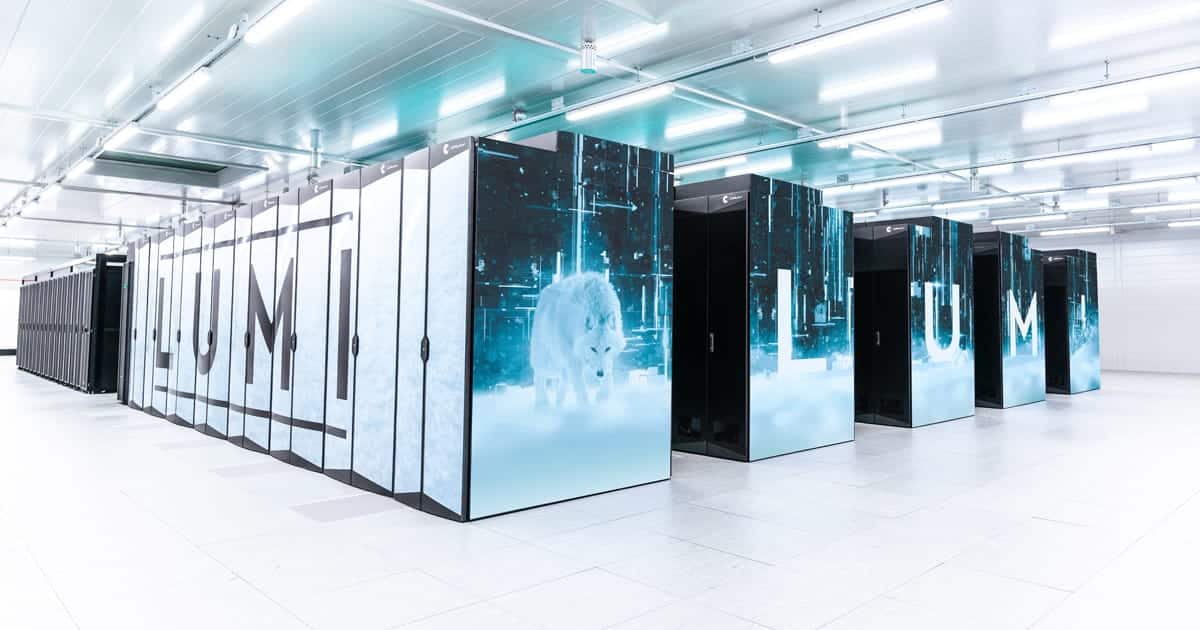Powered by AMD and hydroelectric energy, this computing giant combats climate change, predicts natural disasters, and helps detect diseases such as cancer.
In a scenario that could seem straight out of a science fiction movie, countries across Europe are collaborating to address some of the biggest global challenges with the help of a supercomputer. This isn’t about an alien invasion or a rebellion of artificial intelligences, but rather real problems like climate change, natural disasters, and life-threatening diseases. The technological response to these threats is called LUMI, the most powerful supercomputer in Europe and the eighth fastest in the world, according to the TOP500 list from November 2024.
Located in Kajaani (Finland) and partly funded by the Joint Undertaking EuroHPC, this computing colossus is also supported by a consortium of European countries, including Finland, Sweden, Norway, Iceland, the Netherlands, Belgium, Denmark, Estonia, Switzerland, Poland, and the Czech Republic. LUMI is based on the HPE Cray EX platform, featuring AMD EPYC processors and AMD Instinct MI250X graphics accelerators, a combination that enables it to achieve a sustained performance of 380 petaflops—equivalent to 1.5 million high-end laptops working in unison.
Green Technology for a Sustainable Future
It stands out not only for its power. In the Green500 list, LUMI is ranked as the 25th most efficient supercomputer in the world, operating at 100% with hydroelectric power. Furthermore, its waste heat is reused to heat around 100 homes in the Finnish city that hosts it, making its ecological impact a model of sustainability.
1. Fighting Climate Change
One of the most ambitious projects running on LUMI is Destination Earth, an initiative that models a “digital twin” of the planet with a resolution of just 5 kilometers. The system generates nearly one petabyte of data daily, which would be impossible to process without a supercomputer of this caliber. Thanks to this model, scientists have shifted from updating their climate predictions every 7 to 10 years to doing so once a year or more, allowing for a much more agile response to extreme phenomena.
This digital twin also allows for simulating the impact of new environmental policies, providing governments and institutions with a predictive tool of enormous value to mitigate the effects of global warming.
2. Predicting Natural Disasters
In addition to climate change, LUMI is crucial in anticipating natural disasters, such as floods, cyclones, droughts, or volcanic eruptions. In 2024 alone, at least 3,700 deaths were attributed to phenomena exacerbated by climate change.
One key project is being carried out by the European Centre of Excellence for High-Performance Computing in Exascale for Solid Earth (ChEESE CoE). In collaboration with Icelandic scientists, LUMI is helping to forecast glacier outburst floods, a latent threat in Iceland. These catastrophes, difficult to anticipate due to the complex interaction between climate, ice, and seismic activity, are being simulated using the Elmer/Ice software on the LUMI platform.
Additionally, research is ongoing on volcanic ash, earthquakes, wildfires, and hydrological analyses, with computation cycles reserved for urgent projects, including AI-assisted weather forecasting.
3. Revolutionizing the Fight Against Diseases
In the biomedical field, LUMI is also making a difference. One of its pioneering projects, ComPatAI, uses deep learning techniques to analyze digital tissue samples, particularly in cases of breast and prostate cancer. Coordinated by the Institute of Biomedicine at the University of Turku, this study aims to process over 2.5 million images from Fimlab, the largest clinical analysis provider in Finland.
Thanks to LUMI’s power, the trained AI models can detect signs of cancer that are invisible to the human eye, offering an unprecedented diagnostic tool.
Another line of research aims to model cell membranes at the atomic scale, with the goal of better understanding neurodegenerative diseases like Alzheimer’s, Parkinson’s, or Type 2 diabetes. As these diseases alter cellular composition at levels imperceptible by physical means, simulations on LUMI allow for an entirely new dimension of medical knowledge.
The LUMI supercomputer demonstrates that science and technology, combined with a collaborative international vision, can provide real solutions to the great challenges of our time. Beyond the numbers and technical capabilities, LUMI represents the power of shared knowledge in the service of the common good.


